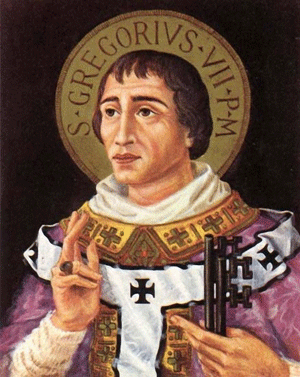
The turn of the millenium mostly lived up to its once-in-a thousand-years hype. It was a thrill to suddenly be living in something called "two thousand." The anticipation of the Y2K computer disaster gave it a kind of edge, with a lot of self-satisfaction afterwards at having known, of course, not to have taken that stuff seriously (I had squirreled away two cases of Dinty Moore Stew in the garage, just in case. Kind of a sad way to go, when you think about it, watching civilization collapse while subsisting on a modest and diminishing larder of canned stew.)
The one big disappointment, for me, was the lack of anything in particular to commemorate as having actually happened a thousand years before. I mean, in 800 there was the crowning of Charlemagne. In 1100 Jerusalem had just fallen in the First Crusade. But in the year one-zero-zero-zero? Zero. It was a purely turn-of-the odometer moment.
For most of us, admittedly, the eleventh century is pretty far off the map. There is that single great exception, immortalized in the title of one of the great comic histories: 1066 and all That. But I'm going to have to make it far beyond 100 to reach 2066.
But now that it's 2015, I've run across a millennial anniversary that's worth more than a passing thought, the birth of Hildebrand in (we think) Anno Domini One Thousand Fifteen. The man who later ruled the Church as Pope Gregory VII.
Attentive readers have no doubt noticed references in late posts to a recent trip to Italy. Rome has a very long history, and we tourists tend to concentrate on two Romes, that of the early Caesars, and that of the Renaissance popes. In between, of course, after the departure of the emperors to Constantinople, and the subsequent sack of the city around the end of the fifth century, Rome went into a prolonged decline. The papacy remained there, of course (aside from a brief sojourn at Avignon), but Hildebrand's Rome must have looked like the set of a deranged Hollywood post-apocalyptic.
H.E.J. Cowdrey, in his biography of Gregory, notes how, by Hildebrand's day, the diminished population had concentrated around St. Peter's Basilica and in the area of the Pantheon, away from the seven hills and the low-lying area between that constituted the heart of imperial Rome, the Forum. We can only imagine the melancholy splendor of the thousand-year-old ruins--the old city walls, the imperial palaces, the lofty temples, falling into decay unless rejuvenated as Christian sanctuaries. Even as late as the quatrocento much of the city was wild, pasture for livestock, and the ruins caves for dwelling or quarries for re-building. It was in this twilight Rome of the eleventh century that Gregory initiated his project to win back the sacerdotal independence of the Church.
For the relationship of the Church and the governing power has always been uneasy, starting with the execution of Jesus and many of the early apostles. The conversion of Constantine must have seemed an unhoped blessing to a generation that lived under the persecutions of Diocletian, but Christian rule raised many new dilemmas and difficulties. Providentially, perhaps, for the bishops of Rome, Constantine moved his imperial capital far to the east, and the close proximity of Emperor and Patriarch was all too often at the expense of the Patriarch. Indeed, a title given to Constantine for the last few years of his life, "Isapostolos," "Equal to the Apostles," suggests how very far the notion of Caesaropapism could go, and how quickly.
So the Roman pontiff was independent, but vulnerable. The second half of the first millenium is replete with popes seeking champions among the new rulers of the West, creating, along the way, a new western Empire, and an increasing tendency on the part of emperors and kings to treat the Church as an adjunct to their domains.
This was probably inevitable, given the de facto status of bishops as centers of authority and administration. It was indeed natural that the new kingdoms utilize the pattern of dioceses--themselves derivative of the Roman cities that once served as the centers of Roman imperial authority. And so almost unconsciously the bishops became functionaries for secular rulers, and that early cooperation necessary for survival became rivalry and, subsequently, quite natural attempts at subordination.
The great effort to disengage the Church from the domination of increasingly powerful lay rulers goes sometimes by the name of the Investiture Controversy, and sometimes by the name of the Gregorian Reform. The first is too narrow, the second exaggerates the importance of a single individual. There is no specific reference to a "Gregorian Reform" during the eleventh century. Many of Gregory's ideals were taken from the program of the reforming Benedictine family of abbeys centered at Cluny. But his pontificate was so pre-occupied with conflict, so strenuous in its clashes with the recalcitrent, that, from our vantage point a thousand years down the road, we see his program as more important, in the long run, than the calling of the Crusades or the beginning of the compilation of canon law in the following decades.
Those of us in the English-speaking world know the sequence best in the martyrdom of St. Thomas Becket, in the provision of Magna Charta for the liberty of the Church, and in the destruction of that balance by Henry VIII. After the Renaissance, in what we've come to call the Age of Absolutism, even the Catholic monarchies began marginalizing the independence of the Church. And, highly symbolically, Cluny itself was destroyed in the French Revolution.
The Church no longer holds the position of countervailing power that it successfully maintained for much of the first half of the second millennium. We moderns on the whole ascribe all plenary authority to the State, as the ancients did to the polis, to the civitate. It's a curious acquiescence, when you think about it. It is certainly unGregorian.




